Preface
Copyright
This publication, including all photographs, illustrations and software, is protected
under international copyright laws, with all rights reserved. Neither this manual, nor
any of the material contained herein, may be reproduced without written consent of
the author.
Version 1.0C
Disclaimer
The information in this document is subject to change without notice. The manufac-
turer makes no representations or warranties with respect to the contents hereof and
specifically disclaims any implied warranties of merchantability or fitness for any
particular purpose. The manufacturer reserves the right to revise this publication and
to make changes from time to time in the content hereof without obligation of the
manufacturer to notify any person of such revision or changes.
Trademark Recognition
Microsoft, MS-DOS and Windows are registered trademarks of Microsoft Corp.
MMX, Pentium, Pentium-II, Pentium-III, Celeron are registered trademarks of Intel
Corporation.
Other product names used in this manual are the properties of their respective
owners and are acknowledged.
Federal Communications Commission (FCC)
This equipment has been tested and found to comply with the limits for a Class B
digital device, pursuant to Part 15 of the FCC Rules. These limits are designed to
provide reasonable protection against harmful interference in a residential installa-
tion. This equipment generates, uses, and can radiate radio frequency energy and, if
not installed and used in accordance with the instructions, may cause harmful inter-
ference to radio communications. However, there is no guarantee that interference
will not occur in a particular installation. If this equipment does cause harmful
interference to radio or television reception, which can be determined by turning the
equipment off and on, the user is encouraged to try to correct the interference by one
or more of the following measures:
•
•
•
•
Reorient or relocate the receiving antenna
Increase the separation between the equipment and the receiver
Connect the equipment onto an outlet on a circuit different from that to
which the receiver is connected
Consult the dealer or an experienced radio/TV technician for help
Shielded interconnect cables and a shielded AC power cable must be employed with
this equipment to ensure compliance with the pertinent RF emission limits governing
this device. Changes or modifications not expressly approved by the system’s manu-
facturer could void the user’s authority to operate the equipment.
Preface
�
ii
Declaration of Conformity
This device complies with part 15 of the FCC rules. Operation is subject to the
following conditions:
•
•
This device may not cause harmful interference.
This device must accept any interference received, including interfer-
ence that may cause undesired operation.
Canadian Department of Communications
This class B digital apparatus meets all requirements of the Canadian Interference-
causing Equipment Regulations.
Cet appareil numérique de la classe B respecte toutes les exigences du Réglement sur
le matériel brouilieur du Canada.
About the Manual
The manual consists of the following:
Chapter 1
Introducing the Motherboard
Chapter 2
Installing the Motherboard
Chapter 3
Using BIOS
Chapter 4
Using the Motherboard Software
Chatper 5
Trouble Shooting
Describes features of the
motherboard.
Go to page 1
Describes installation of
motherboard components.
Go to page 9
Provides information on using
the BIOS Setup Utility.
Go to page 29
Describes the motherboard
software
Go to page 63
Provides basic trouble shoot
ing tips
Go to
page 67
Preface
�
TTTTTABLE OF CONTENTS
ABLE OF CONTENTS
ABLE OF CONTENTS
ABLE OF CONTENTS
ABLE OF CONTENTS
iii
Preface
i
1
Chapter 1
Introducing the Motherboard
1
Introduction...................................................................................1
Feature............................................................................................2
Specifications................................................................................4
Motherboard Components..........................................................6
Chapter 2
9
Installing the Motherboard 9
Safety Precautions............................................................................9
Choosing a Computer Case.............................................................9
Installing the Motherboard in a Case............................................9
Checking Jumper Settings.............................................................10
Setting Jumpers......................................................................10
Checking Jumper Settings......................................................11
Jumper Settings......................................................................11
Installing Hardware...................................................................12
Installing the Processor..........................................................12
Installing Memory Modules...................................................14
Expansion Slots......................................................................16
Connecting Optional Devices.................................................18
Installing a SATA Hard Drive................................................22
Connecting I/O Devices............................................................... 23
Connecting Case Components.....................................................24
Front Panel Header................................................................27
Chapter 3
Using BIOS
29
29
About the Setup Utility........................ ......................................... 29
The Standard Configuration........................ ...........................29
Entering the Setup Utility......................................................29
Resetting the Default CMOS Values....................................30
Using BIOS......................................................................................30
BIOS Navigation Key.............................................................31
Main Menu.............................................................................32
Advanced Menu......................................................................33
Chipset Menu..........................................................................45
M.I.B.III (MB Intelligent Bios III) Menu.................................52
Boot Menu...............................................................................55
�
iv
Security Menu.........................................................................57
Exit Menu...............................................................................60
Updating the BIOS..................................................................61
Chapter 4
Using the Motherboard Software
63
63
Auto-installing under Windows XP/7/8.......................................63
Running Setup.........................................................................63
Manual Installation...........................................................................65
ECS Utility Software .......................................................................65
Chapter 5
Trouble Shooting
67
67
Start up problems during assembly..............................................67
Start up problems after prolong use............................................68
Maintenance and care tips..............................................................68
Basic Troubleshooting Flowchart...................................................69
�
1
Chapter 1
Introducing the Motherboard
Introduction
Thank you for choosing H67H2-M2 motherboard. This motherboard is a high
performance, enhanced-function motherboard designed to support the LGA1155
socket for new 2nd & 3rd Generation Intel® CoreTM Family/ Pentium® / Celeron®
processors*1. To reach the optimum system performance. Combined with ECS
unique M.I.B III BIOS interface, it makes a simple, fast platform for high-end
business or personal desktop market.
This motherboard is based on Intel® H67 Chipset for best desktop platform solution.
H67 is a single-chip, highly integrated, high performance Hyper-Threading periph-
eral controller, unmatched by any other single-chip device controller. This
motherboard supports up to 16 GB of system memory with dual channel DDR3
1600*2/1333/1066 SDRAM. It cooperates one PCIe 16X graphic interface. It also
provides two PCI rev 3.0 slots and one PCI Express x1 rev 2.0 slot for extending
usage. It implements an EHCI compliant interface that provides twelve USB 2.0
ports (four USB ports and four USB 2.0 headers support additional eight USB ports).
The gray USB 2.0 header provides EZ charger technology, please refer to chapter
2 of Front Panel USB headers to check the detail information. This motherboard
implements extra USB 3.0 chip which provide two USB3.0 ports*3 at rear I/O with
blue connector (USB 3.0 feature is optional) also.
The motherboard is equipped with advanced full set of I/O ports in the rear panel,
including one PS/2 keyboard and PS/2 mouse connector, one Ethernet LAN port,
four USB 2.0 ports, two USB 3.0 ports (blue connector) running at 5 Gb/s, one D-
sub (VGA) port, One DVI port (HDMI Port Optional), one Audio Port for
microphone, line-in, line-out and optical SPIDF out.
In addition, this motherboard supports two SATA 6Gb/s connectors and four SATA
3Gb/s connectors for expansion.
*1 When accommodating Intel 3rd Generation CPU, the PCI Express 16X
slot can run at Gen3 speed, which accelerates on 32GB/s rate that effectively
delivers double of PCI Express Gen2 speed.
*2 When you use this MB with 3rd Generation Intel® CoreTM Family Proces-
sors.
*3 The USB 3.0 connectors are optimized for SuperSpeed USB 3.0 devices,
aslo are fully backwards-compatible with Hi-Speed USB 2.0 devices.
Introducing the Motherboard
�
2
Feature
•
•
•
•
Processor
The motherboard uses an LGA1155 type of socket that carries the following
features:
•
Accommodates LGA1155 socket for new 2nd & 3rd Generation Intel®
CoreTM Family/ Pentium® / Celeron® processors
Supports “Hyper-Threading” technology CPU
One PCI Express x16 slot supporting up to 5 GB/s direction peak band-
width
“Hyper-Threading” technology enables the operating system into thinking
it’s hooked up to two processors, allowing two threads to be run in parallel, both
on separate “logical” processors within the same physical processor.
Chipset
The Intel® H67 Chipset is a single-chip with proven reliability and performance.
•
•
•
•
•
•
Supports one PCI Express x1 Gen2 slot
Integrated four SATA 3.0 Gb/s ports and two SATA 6.0 Gb/s ports
Twelve USB 2.0 ports supported
Serial Peripheral Interface (SPI) support
Integrated Graphics Support with PAVP 1.5
Intel® High Definition Audio Controller
Extra Chips (Optional)
•
•
ITE IT8893 Bridge supports two PCI slots expansion
Etron USB 3.0 Controller supports two USB 3.0 ports at the back panel
(Compatible with USB 2.0)
Memory
•
Supports DDR3 1600*/1333/1066 DDR3 SDRAM with Dual-channel ar-
chitecture
Accommodates four unbuffered DIMMs
Up to 4 GB per DIMM with maximum memory size up to 16 GB
* When you use this MB with 3rd Generation Intel® CoreTM Family
Processors.
Audio
•
•
7.1+2 Channel High Definition Audio Codec
Meets Microsoft WLP3.x (Windows Logo Program) audio
requirements
DACs with 97dB SNR(A-weighting), ADCs with 90dB SNR (A-
All ADCs and DACs supports 44.1k/48k/96k/192kHz sample rate
16/20/24-bit S/PDIF-OUT supports 32k/44.1k/48k/88.2k/96k/192kHz
•
weighting)
•
•
sample rate
Introducing the Motherboard
�
3
• Content Protection for Full Rate loss-less DVD Audio, Blue-Ray
DVD and HD-DVD audio content playback (with selected versions
of Win-DVD/PowerDVD/TMT)
• Direct Sound 3D. compatible
Onboard LAN
•
•
•
•
•
•
Supports PCI ExpressTM 1.1
Integrated 10/100/1000 transceiver
Wake-on-LAN and remote wake-up support
Supports PCI ExpressTM 1.1
Integrated 10/100 transceiver
Wake-on-LAN and remote wake-up support
Expansion Options
The motherboard comes with the following expansion options:
One PCI Express x16 slot for Graphic interface
One PCI Express Gen 2 x1 slot
Two 32-bit PCI v2.2 compliant slots
four SATA 3.0 Gb/s connectors and two SATA 6.0 Gb/s connectors
•
•
•
•
Integrated I/O
The motherboard has a full set of I/O ports and connectors:
•
•
•
•
•
•
•
One PS/2 Keyboard and one PS/2 Mouse connectors
One Giga LAN port (10/100M LAN port optional)
Four USB 2.0 ports
Two USB 3.0 ports (USB 3.0 optional & compatible with USB 2.0)
One D-sub (VGA) port
One DVI Port (HDMI Port Optional)
One Audio port with 5 audio jacks (Line in, microphone in, line out)and
1 optical SPDIF out
BIOS Firmware
This motherboard uses AMI BIOS that enables users to configure many system
features including the following:
•
•
•
•
•
The firmware can also be used to set parameters for different processor clock
speeds.
Power management
Wake-up alarms
CPU parameters
CPU and memory timing
Graphic parameters
1. Some hardware specifications and software items are subject to change
without prior notice.
2. Due to chipset limitation, we recommend that motherboard be operated
in the ambiance between 0 and 50 ° C.
Introducing the Motherboard
�
4
Specifications
CPU
•
Chipset
Memory
Extra Chips
(Optional)
Expansion
Slots
Storage
Audio
Giga LAN
Rear Panel I/O
Internal I/O
Connectors &
Headers
•
•
•
•
•
•
•
•
•
•
•
•
•
•
•
•
•
•
•
•
•
•
•
•
•
•
•
•
•
•
•
•
•
•
•
•
•
•
LGA1155 socket for new 2nd & 3rd Generation Intel® CoreTM
Family/ Pentium® / Celeron® processors
Supports “Hyper-Threading” technology CPU
DMI 5.0 GT/S
Intel® H67 Express Chipset
Dual-channel DDR3 memory architecture
4 x 240-pin DDR3 DIMM sockets support up to 16 GB
Supports 1600*/1333/1066 DDR3 SDRAM
* When you use this MB with 3rd Generation Intel® CoreTM
Family Processors.
ITE IT8893 Bridge supports two PCI slots expansion
Etron USB 3.0 Controller supports two USB 3.0 ports at the
back panel (Compatible with USB 2.0)
1 x PCI Express x16 slot
1 x PCI Express Gen2 x1 slot
2 x PCI slots
Supported by Intel® H67 Chipsets
4 x SATAII 3.0 Gb/s Host Controllers
2 x SATAIII 6.0 Gb/s Host Controllers
Realtek ALC892 8-Ch HD audio CODEC
Compliant with HD audio specification
Realteck 8111E Gigabit Lan (10/100 Lan optional)
1 x PS/2 keyboard & PS/2 mouse connectors
1 x D-sub (VGA)
2 x USB3.0 ports (USB 3.0 optional & compatible with
USB2.0)
4 x USB2.0 ports
1 x DVI Port (HDMI Port Optional)
1 x RJ45 LAN connectors
1 x Audio port with 5 audio jacks (Line in, microphone in,
line out) and 1 optical SPDIF out
1 x 4-pin CPU_FAN connector
1 x 3-pin SYS_FAN connector
4 x Serial ATA 3Gb/s connectors
2 x Serial ATA 6Gb/s connectors
1 x Front panel switch/LED header
1 x Front panel audio header
1 x Speaker header
4 x USB2.0 headers support additional 8 USB ports (F_USB1
supports EZ Charger)
1 x Clear CMOS header
1 x LPT header
1 x COM header
1 x SPDIF out header
1 x 24-pin ATX Power Supply connector
1 x 4-pin ATX Power Supply connector
Introducing the Motherboard
�
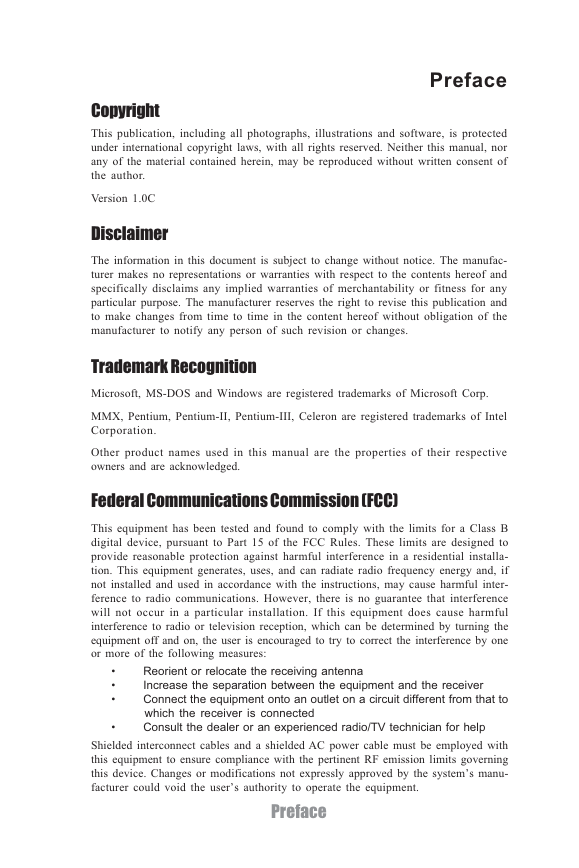
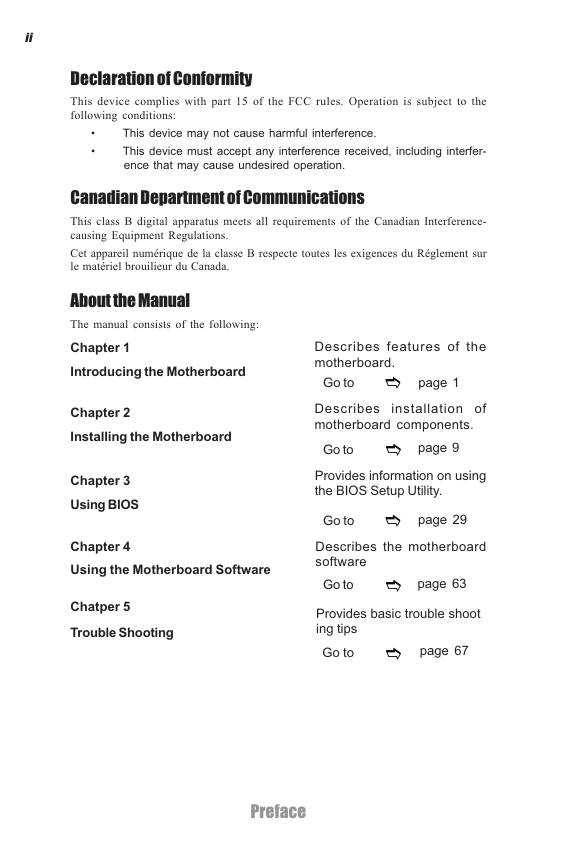

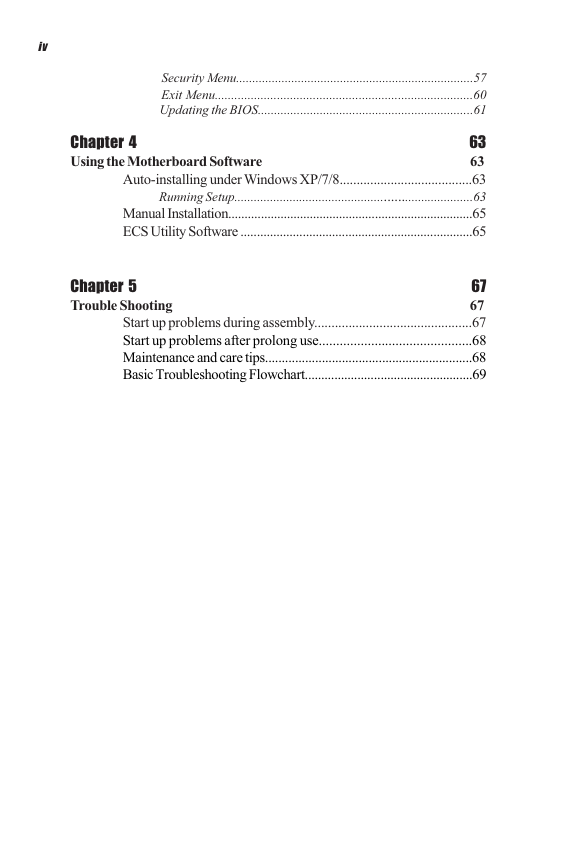
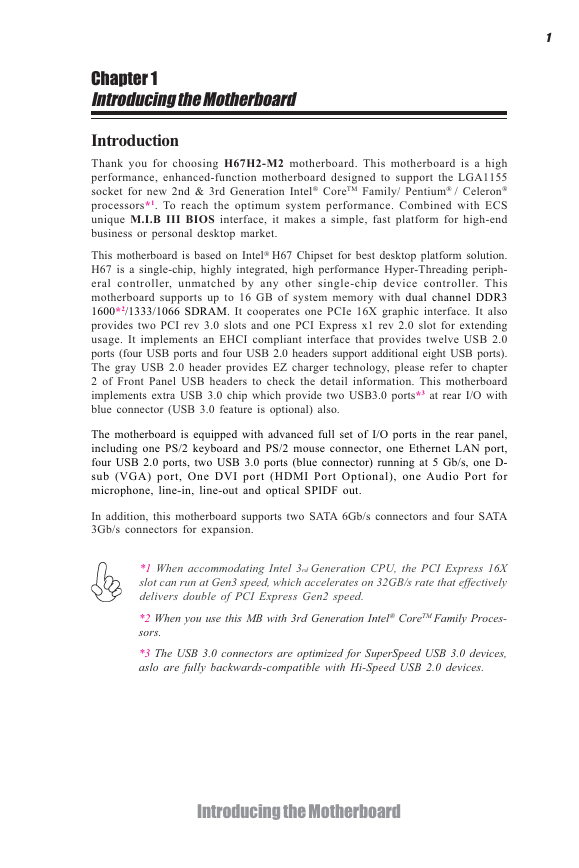
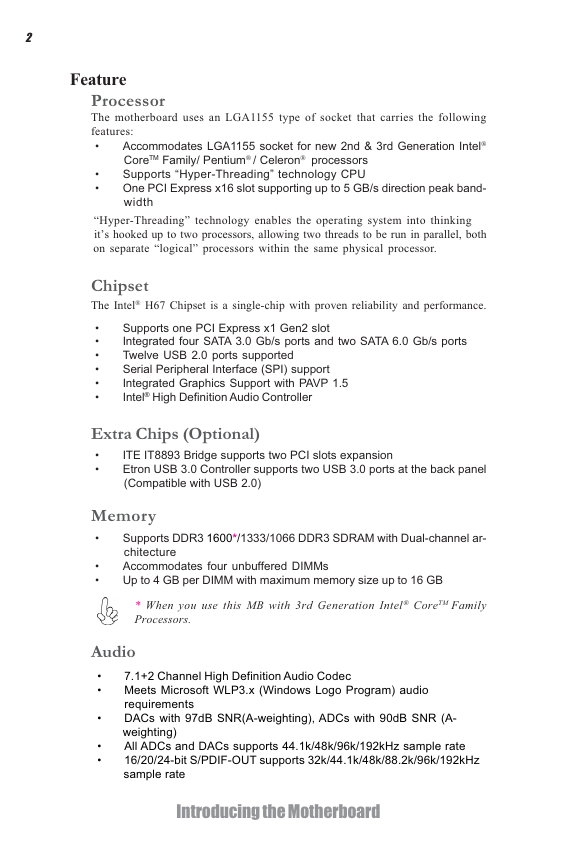
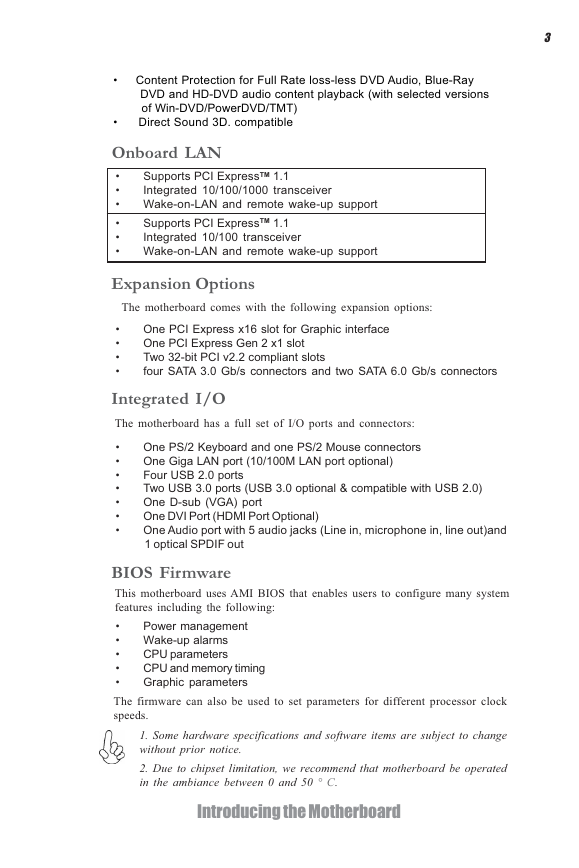









 2023年江西萍乡中考道德与法治真题及答案.doc
2023年江西萍乡中考道德与法治真题及答案.doc 2012年重庆南川中考生物真题及答案.doc
2012年重庆南川中考生物真题及答案.doc 2013年江西师范大学地理学综合及文艺理论基础考研真题.doc
2013年江西师范大学地理学综合及文艺理论基础考研真题.doc 2020年四川甘孜小升初语文真题及答案I卷.doc
2020年四川甘孜小升初语文真题及答案I卷.doc 2020年注册岩土工程师专业基础考试真题及答案.doc
2020年注册岩土工程师专业基础考试真题及答案.doc 2023-2024学年福建省厦门市九年级上学期数学月考试题及答案.doc
2023-2024学年福建省厦门市九年级上学期数学月考试题及答案.doc 2021-2022学年辽宁省沈阳市大东区九年级上学期语文期末试题及答案.doc
2021-2022学年辽宁省沈阳市大东区九年级上学期语文期末试题及答案.doc 2022-2023学年北京东城区初三第一学期物理期末试卷及答案.doc
2022-2023学年北京东城区初三第一学期物理期末试卷及答案.doc 2018上半年江西教师资格初中地理学科知识与教学能力真题及答案.doc
2018上半年江西教师资格初中地理学科知识与教学能力真题及答案.doc 2012年河北国家公务员申论考试真题及答案-省级.doc
2012年河北国家公务员申论考试真题及答案-省级.doc 2020-2021学年江苏省扬州市江都区邵樊片九年级上学期数学第一次质量检测试题及答案.doc
2020-2021学年江苏省扬州市江都区邵樊片九年级上学期数学第一次质量检测试题及答案.doc 2022下半年黑龙江教师资格证中学综合素质真题及答案.doc
2022下半年黑龙江教师资格证中学综合素质真题及答案.doc